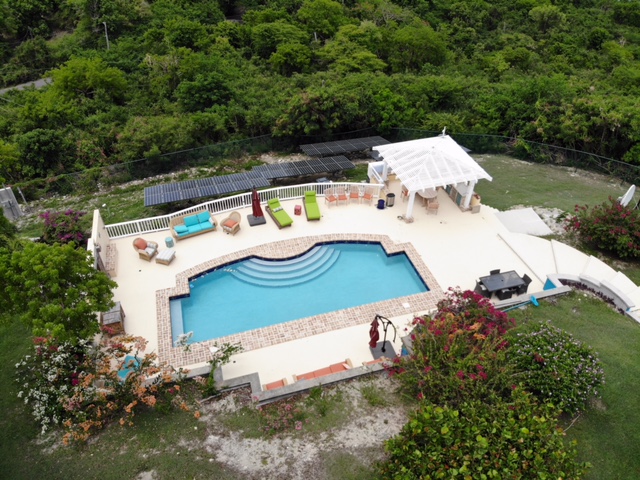Here on St Croix, homes with pools are very popular. It’s an amenity sought out by our buyers.
Recently, we talked about pools with Michael Baker of Seascape Pools on St. Croix and he has some great tips and information we want to share:
What are the different surfaces for pools?
Tile pools are common and beautiful. If tile pools are not kept clean and the chemicals monitored, algae can grow and can deteriorate the grout.
Concrete pools can be painted with a variety of pool paints and colors, or finished with a product like Diamond Brite, one of the best long-term surfaces. Since Diamond Brite has a texture, there is a tradeoff between the beauty of it and staying on top of the maintenance. The Marquee finish is smoother, so it’s easier to maintain. Painted and Diamond Brite surfaces will need to be recoated at some point during their life.
Vinyl pools are really nice, and come in many different prints and colors. With the strong UV light here on St. Croix, the vinyl can fade in 5 to 6 years, depending on how much sun the pool gets, the chemicals used, and the thickness of the vinyl. I wouldn’t recommend vinyl pools to anyone with a dog who would swim in it — dogs’ claws can easily pierce vinyl.
A vinyl liner is also a good repair option, since it can go over an existing surface to fix a leak that can’t be easily or inexpensively repaired. Fiberglass is another type of finish that can fix cracks and leaks, and is easy to maintain.
Can you talk about chlorine vs. salt system pools?
Chlorine pools use floaters with chlorine tablets in them. Think of the rubber duckies with sunglasses! Chlorine is just one of the chemicals that needs to be monitored so that the pool is comfortable to swim in and the chlorine keeps doing its job. That’s a big part of my job, monitoring and adjusting all the chemicals, not just the chlorine.
Salt water pools are the most efficient. Salt water pools use a chlorine generator to convert bulk salt into chlorine. It’s one of the best systems. The higher end systems are very dependable but I’ve found that the cheaper systems can be higher maintenance.
What about filter types?
It depends on the size of the pool as to what you should use. If you have a small pool, the smaller cartridge filters are a good choice. Over a period the time, those cartridges need to be replaced.
The PLD series from Pentair is a different type of filter that uses both a cartridge and DE (diatomaceous earth). These are the best, and are so easy to take apart, spray down the cartridge, and reload.
DE Filters are good filters. They will effectively filter out debris as small as 3 microns whereas other types of filters are in the range of of 5 to 20 microns. They can take a bit more effort to maintain, but when done correctly, the water quality is excellent.
Sand filters are great, and are the lowest maintenance filters. They are large, and take up more room. The pool water circulates through the sand very easily and larger particles of debris are filtered out. The sand does have to be replaced every 5 years or so.
Everything comes down to the chemistry and the ongoing maintenance!
Seascape Pool Center Inc.
Michael Baker
Email here

